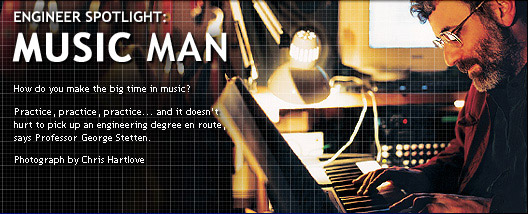Engineer Spotlight: George Stetten

Ever hear the Hendrix-esque wails of a Grimace Guitar? Or the screechings of a Balloon Bassoon? No? Well, chances are you never will, either. But the instruments do exist. Both were built a couple of years ago by graduate bioengineering students at the University of Pittsburgh who took the class Biosignals and Systems II offered by George D. Stetten, an assistant professor.
The Grimace Guitar is wired to the strummer’s noggin. Its sounds are manipulated by the scrunching of the player’s face. As for the Balloon Bassoon, it’s a long balloon half filled with water. At one end it has a microphone, at the other a speaker. Feedback squawks emitting from the microphone are “played” by moving the balloon. “It made a horrendous noise,” Stetten recalls. He now teaches the course to a class of 40 undergraduates and it’s impossible to ask each one to create an instrument. But the entire class did build a rudimentary organ. Actually, it’s more of a cross between an organ and a theremin. It’s a series of oscillators, and when you move your hand over them, you can produce sounds. (A theremin was a forerunner of the synthesizer. Listen to the old Beach Boys’ chestnut, “Good Vibrations”: That’s a theremin making the whistle-like whooo-whoo sound.)
At this point you may very well ask why someone who teaches bioengineering has his students messing around with musical instruments. Good question. Stetten—who has degrees in engineering, neuroscience, and biomedical engineering, as well as a medical degree—is a music buff. And he calls music a wonderful medium for teaching engineering and electronics concepts. Many electrical, computer, and mechanical engineering courses are particularly compatible with music, he says. Moreover, Stetten thinks that engineering schools should do more to train students to work in the multibillion-dollar music industry, which has an insatiable and growing need for engineers.
Electronics is revolutionizing music. Digitalization of music means that, for a few thousand dollars, you can today create in your home a recording studio that would have cost several million bucks a decade ago. “And it’ll have incredibly high quality,” says Stetten. And anyone who has ever downloaded music from the Internet knows how the distribution of music is changing.
The industry already relies on cutting-edge engineering, but most practitioners are traditionally trained engineers who happen to love or play music. Upcoming generations of music engineers, he says, should be specifically trained to marry the two arts. Toward that goal, Stetten thinks engineering schools should develop more courses that emphasize music. Even engineers who go on to work in other areas will benefit from exposure to music, he says. And who knows? Perhaps someone will eventually develop a Balloon Bassoon that makes a harmonious sound.
FOR MORE INFORMATION:
- Institute of Electrical and Electronics Engineers (IEEE)
- The Engineering Alphabet: Electrical Engineering
Filed under: Electrical, Explore Engineering








